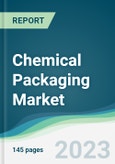The chemical packaging market was valued at US$22.29 billion in 2021 and is expected to grow at a CAGR of 4.72% during the forecast period.
Chemical packaging refers to the specialized containers and materials used for storing, transporting, and protecting various chemicals. It plays a crucial role in ensuring safety, preventing leakage, and maintaining the integrity of the chemicals throughout their lifecycle. Chemical packaging typically involves selecting appropriate materials that are compatible with the specific chemical properties and potential hazards involved. These containers may include drums, bottles, cans, or intermediate bulk containers made from materials like plastic, metal, or glass.Introduction:
The chemical packaging market refers to the industry that provides containers, materials, and services related to packaging chemicals. It encompasses a wide range of products, including drums, IBCs, bottles, and specialized packaging solutions designed to meet the specific requirements of different chemicals. The market is driven by factors such as increasing demand for chemicals across various industries, stringent regulations regarding safety and transportation, and the need for efficient and sustainable packaging solutions. Key players in the chemical packaging market include manufacturers, suppliers, and distributors who cater to the diverse needs of chemical producers and end-users, ensuring the safe handling, storage, and transportation of chemicals while adhering to regulatory standards.Drivers:
- Increasing demand for chemicals:
- Stringent safety regulations:
- Hazard communication and labelling requirements:
- Technological advancements:
- Increasing focus on sustainability:
- Growth of the e-commerce sector:
- Globalization and international trade:
- Industry-specific packaging requirements:
- Product differentiation and branding:
- Focus on product integrity and shelf life:
Products offered by key companies:
- BASFlaunched a new line of packaging made from chemically recycled plastics. This type of plastic is made from waste plastic that has been broken down and then repolymerized into new material.
- Shelllaunched a new line of lubricant bottles made from recycled plastic. The bottles are made from 100% post-consumer recycled resin (PCR), which means that they are made from plastic that has already been used and recycled ones.
- Kiko Milano launched a new line of makeup packaging made from recycled plastic and paper. The packaging is also designed to be recyclable so that it can be easily disposed of at the end of its life.
Positive growth in the sustainable packaging segment:
The segment that is experiencing significant growth in the chemical packaging market is sustainable packaging. With increasing emphasis on environmental sustainability and regulatory pressure to reduce carbon footprint, the chemical industry is actively adopting sustainable packaging solutions. Sustainable packaging incorporates materials and practices that minimize environmental impact, such as recycled content, biodegradability, and eco-friendly designs. This segment's growth is driven by the demand for eco-conscious packaging options that align with sustainability goals and regulations, as well as the positive brand image associated with environmentally responsible practices. Manufacturers that offer sustainable packaging solutions cater to the rising demand for greener alternatives, contributing to rapid growth in this segment of the chemical packaging market.Asia-Pacific region is expected to hold a significant share:
The Asia-Pacific region is expected to dominate the chemical packaging market share. Several factors contribute to this dominance, including rapid industrialization, urbanization, and the presence of key chemical manufacturing hubs in countries like China and India. The region's strong economic growth, coupled with a rising population and increasing consumer demand, drives the demand for chemicals and subsequently fuels the need for efficient packaging solutions. Furthermore, government initiatives supporting industrial development and infrastructure investments in the region further bolster the dominance of the Asia-Pacific chemical packaging market.Key developments:
- In February 2023,In order to promote circularity in the markets for heavy-use packaging, TotalEnergies and Ecolab have teamed together to introduce plastic packaging integrating recycled material.
- In Dec 2022,BASF and StePac have teamed up to create sustainable packaging for fresh produce. BASF will supply StePac with its chemically recycled polyamide 6, Ultramid Ccycled, enabling the development of contact-sensitive packaging formats within the circular economy. This partnership aims to reduce plastic waste and extend the shelf life of produce.
Segmentation:
By Packaging Type
- Bags and Sacks
- Intermediate Bulk Containers (IBC)
- Pails and Drums
- Flexible IBCs AND related Flexible Packaging Products
- Others
By Application
- Commodity Chemicals
- Specialty Chemicals
- Petrochemicals
- Others
By Material
- Metal
- Plastic
- Others
By Geography
- North America
- United States
- Canada
- Mexico
- South America
- Brazil
- Argentina
- Others
- Europe
- United Kingdom
- Germany
- France
- Italy
- Spain
- Others
- Middle East and Africa
- Saudi Arabia
- UAE
- Others
- Asia Pacific
- Japan
- China
- India
- South Korea
- Taiwan
- Thailand
- Indonesia
- Others
Table of Contents
1. INTRODUCTION
2. RESEARCH METHODOLOGY
3. EXECUTIVE SUMMARY
4. MARKET DYNAMICS
5. CHEMICAL PACKAGING MARKET, BY PACKAGING TYPE
6. CHEMICAL PACKAGING MARKET, BY APPLICATION
7. CHEMICAL PACKAGING MARKET, BY MATERIAL
8. CHEMICAL PACKAGING MARKET, BY GEOGRAPHY
9. COMPETITIVE ENVIRONMENT AND ANALYSIS
10. COMPANY PROFILES
Companies Mentioned
- Greif Inc.
- Mauser Packaging Solutions
- Mondi Group
- ProAmpac
- Hoover CS
- SolvChem Custom Packaging
- LC Packaging Group
- CDF Corporation
- Peak Liquid Packaging
- Conitex Sonoco
Methodology

LOADING...
Table Information
| Report Attribute | Details |
|---|---|
| No. of Pages | 145 |
| Published | December 2023 |
| Forecast Period | 2021 - 2028 |
| Estimated Market Value ( USD | $ 22.29 Billion |
| Forecasted Market Value ( USD | $ 30.78 Billion |
| Compound Annual Growth Rate | 4.7% |
| Regions Covered | Global |
| No. of Companies Mentioned | 10 |








